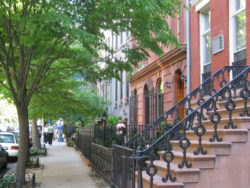
Chelsea neighborhood in Manhattan. Image credit: GK tramrunner229
City neighborhoods report threats to affordable housing. The Association for Neighborhood & Housing Development released its 2018 report on “How Is Affordable Housing Threatened in Your Neighborhood?” The report provided its findings in a chart on all neighborhoods in the five boroughs and indicators of threats to affordable housing. The Association is the umbrella organization of 100 non-profit affordable housing development groups, which serves low- and moderate-income residents in all five boroughs.
The chart included indicators such as the unemployment rate in 2016, rent burden in 2016, evictions performed by marshals in 2017, at-risk Mitchell-Lama units in 2020-2022, at-risk HUD subsidized units in 2018-2022, and housing litigations in 2017. They scored all neighborhoods on the threats to affordable housing. The scores ranged from zero to 27, with 27 as the highest threat.
The neighborhood of Bayside/Little Neck in Queens scored zero in threats to affordable housing and the University Heights/Fordham neighborhood in the Bronx had a score of 27. Seven of the twelve neighborhoods in the Bronx and three of the 18 neighborhoods in Brooklyn scored above 19, while Manhattan, Queens, and Staten Island had no neighborhoods scoring above 19.
The Brownsville neighborhood in Brooklyn had the highest unemployment rate in 2016 with 14%, followed by University Heights/Fordham and Belmont/East Tremont with 12.7% and 12.6% respectively. Bayside/Little Neck neighborhood reported the lowest unemployment rent at 2.7%.
Borough Park in Brooklyn reported 60.2% with rent burden in 2016. Jackson Heights, Elmhurst/Corona, Flushing/Whitestone, University Heights/Fordham, and Kingsbridge Heights/Bedford neighborhoods reported rent burden percentages above 50%. Brooklyn Heights/Fort Greene reported the lowest rent burden at 27.2%.
The Throgs Neck/Co-Op City neighborhood has 15,515 Mitchell-Lama units at risk for 2018-2022. There are over 1,000 HUD subsidized units at risk in Belmont/East Tremont, Borough Park, Coney Island, Lower East Side/Chinatown, Upper East Side, and East Harlem.
The findings by the report showed that the City is losing affordable rent-stabilized units at a fast rate, with neighborhoods like Astoria, Central Harlem, and Bedford Stuyvesant losing over 400 units between 2015 and 2016. Other findings showed that many City-backed and Federally-backed affordable units are eligible to expire or at risk of losing subsidies.
Benjamin Dulchin, Executive Director of the Association for Neighborhood & Housing Development, stated that “The crisis of affordable housing is so much part of the daily experience of almost all New Yorkers that it’s the water we swim in. But some people and some neighborhoods are experiencing the crisis and the displacement pressure more severely, and with more devastating consequences to their families and their communities.”
To read about the chart’s data sources, click here.
By: Dorichel Rodriguez (Dorichel is the CityLaw Fellow and a New York Law School graduate, Class of 2017.)

